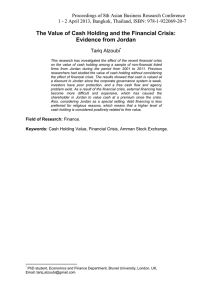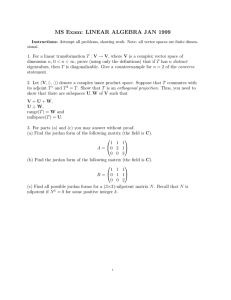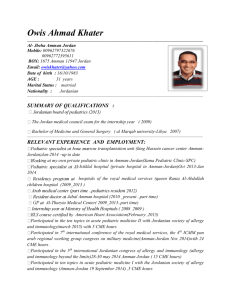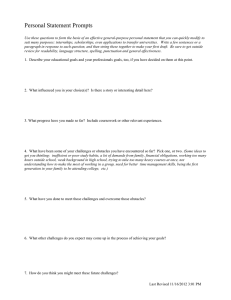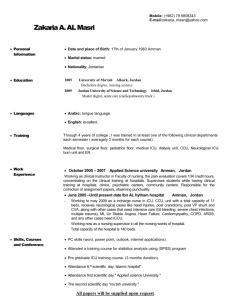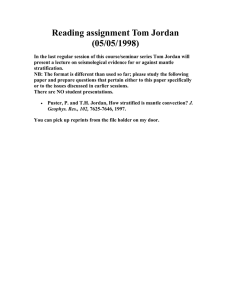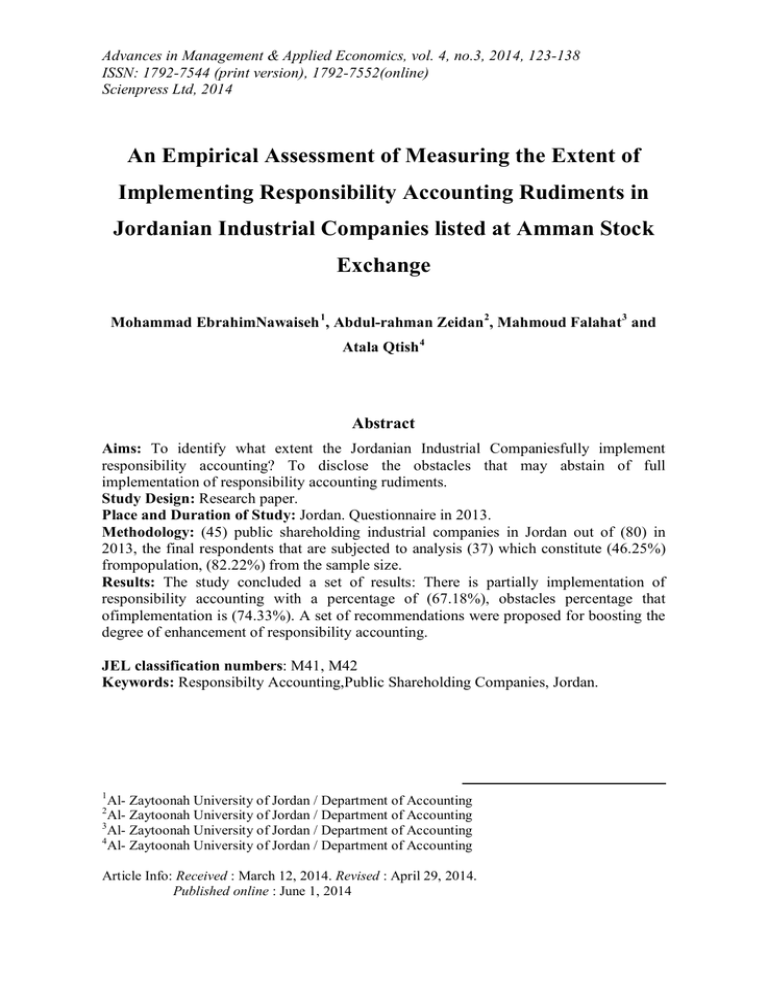
Advances in Management & Applied Economics, vol. 4, no.3, 2014, 123-138
ISSN: 1792-7544 (print version), 1792-7552(online)
Scienpress Ltd, 2014
An Empirical Assessment of Measuring the Extent of
Implementing Responsibility Accounting Rudiments in
Jordanian Industrial Companies listed at Amman Stock
Exchange
Mohammad EbrahimNawaiseh 1, Abdul-rahman Zeidan2, Mahmoud Falahat 3 and
Atala Qtish 4
Abstract
Aims: To identify what extent the Jordanian Industrial Companiesfully implement
responsibility accounting? To disclose the obstacles that may abstain of full
implementation of responsibility accounting rudiments.
Study Design: Research paper.
Place and Duration of Study: Jordan. Questionnaire in 2013.
Methodology: (45) public shareholding industrial companies in Jordan out of (80) in
2013, the final respondents that are subjected to analysis (37) which constitute (46.25%)
frompopulation, (82.22%) from the sample size.
Results: The study concluded a set of results: There is partially implementation of
responsibility accounting with a percentage of (67.18%), obstacles percentage that
ofimplementation is (74.33%). A set of recommendations were proposed for boosting the
degree of enhancement of responsibility accounting.
JEL classification numbers: M41, M42
Keywords: Responsibilty Accounting,Public Shareholding Companies, Jordan.
1
Al- Zaytoonah University of Jordan / Department of Accounting
Al- Zaytoonah University of Jordan / Department of Accounting
3
Al- Zaytoonah University of Jordan / Department of Accounting
4
Al- Zaytoonah University of Jordan / Department of Accounting
2
Article Info: Received : March 12, 2014. Revised : April 29, 2014.
Published online : June 1, 2014
124
Mohammad EbrahimNawaiseh et al.
1 Introduction
The management accounting plays a vital role by providing organisations with
information for enabling planning , controlling , decision making , and through past
decades with the modern technological development in information technology
,production ,and competionincease , a need has occurred to developing and using of
managerial techniques , in addition to the severe competition among corporations at this
time , that has come into existence due to the global markets’ openness , consequently ,
this develop for technology use has encouraged much demand on these information ,more
accurate , and on time to cope with the customers’ wish for decision making , adding to
this , most companies , concentrated the attention on product quality , also on the
classification of the operations to various activities , to get more précised information for
the purpose of its products’ costs determination , for the changes in information
technology , for the cosumers’ demnand , the management accountant’s role has changed
from the traditional role ,to more efficient one , through assigning him among the
managerial team for planning , and decision making to get most profitable situation for
the business ,dhaher[1]. From the Islamic religion point of view , the noble Qur’an and
the noble Suna , refer to responsibility accounting , where the Quraa’n cleared that the
individual is responsible in front of allah about his deeds and behaviours in this life in
what is the things are tiny or not , allah says in holy Qur’an : “So whosoever does good
equal to the weight of an atom (or a small ant ) shall see it , And whosoever does evil
equal to the weight of an atom (or a small ant ) shall see it “ , Zalzala(The earth quake[2],
one of our messenger prophet Mohammad’s sayings(Hadith) (Peace be upon
him)aboutresposibiltybasis is :“All of youare responsible and quardians for hissubjects ,
the ruler is quardianof his subjects , the man is quardian of his family ,the woman is
quardian and is responsiblefor her husband’s home and his offspring , and so, all of you
are quardian and are responsible for his subjects “, “The following quotation from
Mohammad, the God's messenger (PBUH) must be considered in the general way: (Audit
yourself(discharge your accountability) before being audited) contrary to a complete
transparency which might be inferred from the appearance of the quotation.”Albukhari
and Muslim[3]. Responsibility accounting system denotes : setting the accounting data in
a proper reports , as per individual’s accountability , for the purpose of presenting
information about the activity performance for every single division or department that
would be from the individual’s responsibility , which in turn , this report contains in
details , all items that should be included within the responsibilty’ scope for that person ,
the other cost items that are not within the person’s responsibility should be out of that
responsibility , on that basis , one can say that responsibility accounting objective is to
accumulate the data for a single activity through a period of time , then compared with the
estimated one , and to dessiminating it in a report for evaluating the individual’s
performance , for this cause , this system might be nominated as a responsibility system
for costs ,Joma’a, [4]. The responsibility accounting can be defined as the accounting
system appointed by the entity to pursue cost elements, preparing of performance reports
for different managerial levels within the entity , or , can be defined as an activity
accounting , which means , to connect the predetermined rates for activity cost elements
with responsibility centers , compared with actual rates for the elements to determine the
variances’ responsibility ,Al-sherief [5] . From the above concepts for responsibility
accounting, it can be said that this system is considered as a tool for directing the
emloyees within the entity to enhance the favorable variances, to minimize the
Implementing Responsibility Accounting Rudiments in Industrial Companies
125
unvafourable, in order to encourage employees todeveloping the innovative spirit among
them for getting the optimum investment to the available resourses.
2 Literature Review and Previous Studies
In responsibility accounting, the debate as to the scope of appropriateness of
responsibility continues to rage. Bevan and Messner[6] identify that much of the debate
revolve around the controllability principle which states that managers should be made
responsible only for those activities, objectives or outcomes with which they have
influence or controlAn important characteristic of management control systems is the use
of responsibility accounting. As Baiman [7] notes: "Responsibility accounting states that a
person should be evaluated only on the basis of those factors that he controls. This is
usually interpreted to meanthat a person should be evaluated only on the basis of those
outcomes that he affects [emphasis in the original]." This notion gives rise to the desire to
distinguish between controllable and noncontrollable costs because the latter presumably
should not be used to evaluate an individual'sperformance. One of the most objectives that
responsibility accounting to achieve is cost control via budgetary control for each
responsibility center at the beginning of the period , and comparing the actual
achievements with the budgeted ones , for the purpose of evaluating responsibility centers
, and to determine the variances at sourse , by taking both the standard costing system and
budgets , the budget has operational , capital and cash activities . Responsibility
accounting as a control device emphasizes responsibility centers. These are subunits of an
organization under a specific manager’s control and hence having direct responsibility for
its activities Fowzia[8].There are five main responsibility centers for the purpose of cost
control. These are cost center of which a manager is held accountable for the costs in the
subunit; revenue center of which a manager is held accountable for the revenue subunit;
profit center of which a manager is held accountable for the profit subunit; investment
center of which a manager is held accountable for the profit and the capital invested to
generate that profit in the subunit; contribution margin centre of a manager is held
accountable for the contribution in that subunit.The responsibility accounting system is
one of the important systems in the company, because of its benefits obtained, this system
depends upon a group of elements, that can be summed up as follows, Al-sherief [9] :
1) Accounting Information System: The system of responsibility accounting depends on
the interrelation between accounting information system and organizational structure of
the company. The standard costing system provides responsibility accounting with
quantitative standards to performance evaluation ,determine the controllable and
noncontrollable costing, for this reason, it can the controllable costs be determined for a
particular person, in order to avoid the conflicts among employees , and a ccounting
documents prescribed as evidence in case of conflicts among employees in centers of
organizational structure of the company.
2) Decentralization: It means dividing the company into responsibility centers, in
addition to decision making on the lower management level, on other words, more
decisions on the lower level, more decentralization , and more determination for authority
and responsibility.
3) Management by Exception : This principle assists in presenting the performance of
responsibility centers , for this case , the upper levels of management are aware with
126
Mohammad EbrahimNawaiseh et al.
operations and extraordinary items performed on the lower levels of company’s
organizational structure .
4) Motivation System: This system of positive incentives will raise the behavioral
motivation from the employees point of view , to achieve the predetermined targets , in
which the laborious employee be remunerated , encouraged ,or punished according to the
achievement degree .
Responsibility accounting is a system of accounting that segregates revenues and costs
into areas of personal responsibility in order to monitor and asses the performance of each
part of an organization. The concept of responsibility accounting is central to any
effective profit planning and control system. Someone must be held responsible for each
cost or else no one will be responsible and the cost will inevitably grow out of control. In
the same vein Zimmerman [10], says responsibility accounting system is part of the
performance evaluation system used to measure the operating results of the responsibility
center. Responsibility accounting then dictates that the performance measurement system
measures the performance that results from the decision rights assigned to the
responsibility center.MojganSafa [11] mentioned as the centralized operations in
organizations become more complicated in case of business development, the need to
delegate authorities and responsibilities will depend on the size of the business. In a
decentralized business organization, directors are responsible for planning and controlling
the corporate operation. If the authority to manage daily operations is transferred from
high-level managers to middle managers, the former will have more opportunity to focus
on strategic planning. The responsibility accounting system is designed to report and
accumulate costs by individual levels of responsibility. Each supervisory area is charged
only with the cost for which it is responsible and over which it has control. There are
three basic types of responsibility centers: cost centers, revenue centers, and investment
centers. When budgeted amounts are compared with actual amounts and deviations are
found, responsibility accounting can be used to find the causes of such deviation and
hence improve the function. Al-shomaly[12] in his study aims to disclose the methods that
are used to evaluate the performance in the medical care sector in Jordan and the extent of
their relation with the responsibility accounting principles. In order to achieve this goal, a
questionnaire had been designed to obtain information of the sample which represents the
medical institutions in the north of Jordan (NGOs and private sector). The study
concluded that the medical institutions in northern Jordan are partially adopting the
fundamentals of responsibility accounting system in the evaluation of its performance, but
informally. This conclusion is supported by; First, The presence of definite organizational
structures, where the centers (cost and profit centers) were divided according to those
structures. Second, the absence of systematic preparation for budgets to each
responsibility center. Third, the tendency toward decentralization(delegation of authority)
in these institutions were weak, where there was significant influence by top management
in the process of decision making and performance evaluation in centers and at the entire
organization level . While some Patel [13] refer to responsibility accounting in the large
companies, is tool of a good control system. This is a system of responsibility,
accountability, and performance evaluation. There are many control systems in the
accountancy; they all are controlled on the whole organization, while this control system
is that it is relevant to measurement of performance of divisions of an organization. Thus,
Budgeting and standard costing are part of the responsibility accounting process.
Responsibility Accounting is very much related with the size of an organization. It is
useful for the large-scale companies, while small-scale companies are not useful as
Implementing Responsibility Accounting Rudiments in Industrial Companies
127
compared to large scale. Generally, this system is useful in those companies which
produce very large varity of products and works on large scale, like Hindustan Uniliver
Ltd. while in small scale companies this is not as such controllable as large scale
companies. Responsibility Accounting is a method of accumulating and reporting both
budgeted and actual costs, by divisional managers responsible for them. In this system,
business activities are identified with persons rather than products for that to make
effective control to appoint a manager. Horngren has defined responsibility accounting as,
“a system of accounting that recognizes various responsibility centers throughout the
organization and reflects the plans and actions of each of these centers by assigning
particular revenues and costs to the one having the pertinent responsibility.”
Responsibility Accounting is also defined as, “that segregates revenues and costs into
areas of personal responsibility, in order to assess performance attained by persons to
whom authority has been assigned.” Other study ,Nyakuwanika, et.al [14] , sets out to
come up with strategies to ensure effective responsibility accounting system in the
Ministry of Health and Child Welfare (MOHCW) in Mashonaland West Province of
Zimbabwe. The study was largely prompted by the fact that despite having been
professionalized in its functions, the Ministry was still facing many challenges. The target
population for the study was the management and a sample of 70 employees from the
fourteen stations in the province was used. Systematic sampling (probability sampling)
and purposive or judgmental sampling (nonprobability sampling) were used. It was
observed that departments were operating with mandated budgets and that planning and
control were not integrated. In addition it was also observed that performance reports
were being used to fix blame on management and that performance reports were not being
distributed to sectional managers on a regular basis. It has been recommended that when
coming up with budgets for the province the leadership should allow station managers to
participate in the budget formulation and their suggestions should be taken on board and
Incorporated in the master budget.Islam is a: [. . .] comprehensive way of life that results
from one living in a state of surrender to God (whereby) all daily living (are sanctified)
into worshipful acts that unify life in a manner consistent with the Tawhidic principle of
the divine unity, self-purification and self-perfection through worship, the ongoing
acquisition of knowledge and performing of selfless (deeds) Krauss et al.[15].The purpose
of Islamic legislation (shari’ah) is to fulfill compassion and guidance within society at
large, by establishing and enacting the concepts of ‘‘justice, eliminating prejudice, and
alleviating hardship by promoting cooperation and mutual support’’ .Dusuki and
Abdullah[16]. Like other monotheistic religions, Islam establishes a core focus on
accountability of deeds in front of God (Allah). Thus, the shar’iah incorporates laws and
regulations that aim at improving and facilitating human lives and serve the benefits of all
such beneficiaries, where the proper norm for God is Al-Akhirah (the eternal
afterlife/hereafter).The Holy Qur’an also clearly states : ‘‘There is no compulsion in
religion’’ Qur’an [17].This renders the myth of violence in Islam irrelevant since if people
are violently requested to become Muslims, they still cannot be considered Muslims since
Islam is an internal act of theheart. According to the Islamic framework, human beings
also differ in their level of religiosity. Religiosity represents ‘‘a belief in God
accompanied by a commitment to follow principles believed to be set by God’’McDaniel
and Burnett [18]. Vitell et al. [19] presented a ‘‘call for interdisciplinary research
regarding religiosity’’, whereas Spilka et al. [20] note that most of the research in this
domain had focused on the ‘‘Judeo-Christian framework.’’Scholars have reviewed the
concept of Islamic social responsibility to encompass a broader meaning that embraces
128
Mohammad EbrahimNawaiseh et al.
the ‘‘taqwa’’ or God consciousness dimension. This concept means that corporations as a
group of individuals do assume the roles and responsibilities as servants and vicegerents
in all situations. Thus, relationship with God should inspire the values of truthfulness,
fairness, kindness, uprightness rather than envy, backbiting and discrimination in the
corporate setting, where such relationship should be held in business activities as well as
in with all stakeholders Siwar and Hossain[21]. From the literature review mentioned, it
can be said , despite the role that management accounting techniques play , there was no
study occurred – to the best of the rearchers’ knowledge – about this topic in Jordainian
industrial public share holding companies, for this cause , the exploratory study has been
furnished, its importance is coming from the vital role of responsibility accounting itself
, the need for recruiting the efficient Certified Management Accountant through showing
some of the factors that are affecting responsibility accounting with the accountability
system effectiveness , in addition to know the obstacles to minimize the cost for the
decision making. The questionnaire focused on the most of responsibility accounting
features. Planning and control are often confused, and these areintermittently used to
suggest that they are synonymous or have same meaning. Essentially, planning and
control are complementary but not synonymous. Planning embroils the development of
objects and putting in place various budgets to accomplish those planning. According to
Lucey[22], Planning establishes the objectives, and formulate, evaluate and select
policies, strategies, tactics and actions required to achieve these objectives. It comprises
long term and short term strategies.Finally, effective implementation requires the
presence of precisely prepared budgets in order to measure the performance of each
division on the basis of actual and planned results as indicated by Odum [23] .Based on
the preceding literaturereview , the study problem can examine if management
accounting’s staff in Jordanian industrial public share holding companies listed at Amman
stock exchange realize to what extent these companies implement responsibility
accounting, and what are the obstacles that the management accounting staff might face
on the light of such applicability.However, the study providing an empirical evidence
from Jordan in implementing responsibility accounting. The outcome of this study could
benefit the following sectors: Securities and Exchange Commission (SEC), the academe,
the management of concerned industrial public shareholding companies.
3 Research Methodology
3.1 Sample Size, Data Collection
This study has two sources of information , descriptive through the library’s survey , the
related previous studies for the purpose of setting the basis that the study’s background
depends upon , the analytical side has a questionnaire survey was used to determinethe
"state of the art" for responsibilityaccounting,the questionnaire circulated by hand to (45)
public shareholding industrial companies in Jordan out of (80) in 2013, the
returedquestionnairs are (43) , the final respondents that are subjected to analysis are
(37) which constitute (46.25%) from population , (82.22%) from the sample size , the
questionnaire classified into three parts , personal variables (Qualification, Specialization,
Age, Gender, and Professional Certificates),the second part includes some of the
responsibility accounting reudiments (1-12) , whilist the last part has focused on the
obstacles that may deter the application of responsibility accounting (13-32) . All the
Implementing Responsibility Accounting Rudiments in Industrial Companies
129
questionnaire’s questions have been formulated by five Likertscale , taking (5) as strongly
agree ,and (1) strongly disagree .
3.2 Data Analysis and Hypotheses Testing
The Degree of compliance (importance) which is mathematically expressed by:
(Arithmetic Mean) ÷ (higher weight to the question) (100%) . The one-sample t-test is
used to know whether the sample comes from a particular population but we do not have
full population information available to us. Analysis of variance (ANOVA) is used to
analyze the differences between group means and their associated procedures, it provides
a statistical test of whether or not the means of several groups are equal, and therefore
generalizes t-test to more than two groups. For this reason, ANOVAs are useful in testing
three or more variables for statistical significance, level of significance chosen in this
study 0.05. The consistency level can be determined through inter-item consistency
reliability. The consistency test that is commonly used specifically for multipoint-scaled
items is the Cronbach’s Alpha coefficient Hair [24].Itis the most common measure of
internal consistency (reliability) ,and most commonly used when we have multiple Likert
questions in a questionnaire that form a scale and we wish to determine if the scale is
reliable. If reliability Coefficient is ≥ (60%), it would be accepted according to sekaran
[25].For data collected from the survey, all items in section (B) and (C) were subjected to
the reliability test. The findings of the reliability test for each section of the questionnaire,
and normality tests are presented in the Table (1). Validity and Reliabilitymeasures have
been tested for the last two parts of the questionnairspharagraphs; these tests were as
follows in table (1) and (2) respectively:
Item
1
2
3
4
5
6
7
8
9
10
11
Corrected
Item-Total
Correlation
-.049
-.026
.376
.764
.547
.387
.658
.470
.185
.602
.535
Table 1: Validity Correlation Test
Corrected
Item
Item-Total
Correlation
12
.557
13
.679
14
.473
15
.267
16
.661
17
.359
18
.324
19
.683
20
.510
21
.545
22
.667
Item
23
24
25
26
27
28
29
30
31
32
Corrected
Item-Total
Correlation
.394
.159
.742
.501
.389
.419
.623
.250
.594
.507
Table number (1) shows the validity of the paragraphs, in which these questions are
proper to the required measure set for it, while the reliability coefficient is satisfied by the
following two mesures taken ; (Cronbach’s Alpha) and (Split-Half Coefficient) as per
table no.(2).
130
Mohammad EbrahimNawaiseh et al.
Paragraphs
1-17
18 - 32
1 - 32
Table 2: Reliability Coefficient Tests
Title
Split-Half
Coefficient
r
Rudiments
.804
.672
Obstacles
.871
.771
All
.672
.504
Cronbach’s α
86.60%
89.90%
90.20%
All paragraphs numbered in table (2) follow the normal distribution, paragraphs (1) – (17)
are replaced with (x1) , paragraphs (18)-(32)expressed by (x2), (Split-Half Coefficient)
for calculating Spearman-Brown Coefficient through the following formula: Where (r) is
correlation coefficient, [(2r) / (1+r)] , figure (1) Shows the normality.
Figure 1
Five individual information were involved in the data collection, namely, Qualification,
Age, Academic specialization, Professional Certificates, and gender. Table (3) presents
the descriptive statistics of the final sample in this study.The study’s sample respondents
are from management accounting staff in the Jordanian industrial public shareholding
companies listed in Amman stock exchange in 2013, table no.(3) represents the study
sample’s characterstics , (83.8%) are males , high percentage (83.3%) having an age more
than (40) years , (91.9%) having undergraduate , while the specialization percentage
(89.2%) is for accounting .
Implementing Responsibility Accounting Rudiments in Industrial Companies
No.
1
2
Table 3: Demographic Profile of Respondents
Class
Community college
Qualification
undergraduate
graduate
< 30
Age
30 - 40
Title
3
Spcialization
4
Professional
Certificate
5
Gender
40 - 50
≥50
Accounting
Management
Others
JCPA ,ACPA
CMA ،CPA
None
Male
Female
ﺍﻟﻌﺪﺩ
131
%
0
34
3
0
6
0
91.9
8.1
0
16.2
31
0
33
1
3
5
0
32
31
6
83.3
0
89.2
2.7
8.1
13.5
0.0
86.5
83.8
16.2
Study Model
Inedependent
Dependent:
Cotrolling Variables
Implementing of
Rspons. Acc.
Responsibility Acc.
Rudiments
Obstacles Variable
Thus, the following three listed hypotheses arebelow:
Ha1: Management accounting staff realizes the availability of responsibility
accountingrudiments (features) in Jordanian industrial public shareholding companies.
By analyzing these (13) factors that are related to responsibility
accountingrudiments(features) , the responses for the majority were ranged (63.24% -
132
Mohammad EbrahimNawaiseh et al.
72.43%) , with an average beween (3.16 – 3.62) for all paragraphs shown in tables nos.(4)
,and (5), the highest average is for paragraph(13)that is related to theorganizational
structurein the company,with percentage (72.43%), the lowest percentage is for paragraph
no. (4) which is related to budgetary control technique that is applied in the company with
(63.24%), followed by paragraph no.(8) , that has focused on standard cost in respective
centers , in general , the average for all paragraphs is (3.47) or (69.4% ) , which is within
class (3 - 4), the standard deviation is (0.40)for all , which means no dispersity in the
respondent’s opinions seen.
0B
1B
3
The currentorganizational structure is
effective
4
2B
Budgetary control technique is applied
in the company
There is aJob description
5
3B
6
4B
Speciality in responsibility centers
7
5B
Availability of respons .center manager
8
6B
Standard cost in respective centers
9
7B
Clarity of organizational structure
10
8B
Coordination among Resp.centers
11
9B
ClassificationOf centers’
revenues
Aclearinterlations among these centers
10B
1B
12
13
12B
There is aorganizational structureIn the
company
There is association between rev. costs
for each resp.center
There is a standard for performance
evaluation in resp.center.
There are harmonization among all
14
13B
15
14B
16
16B
15B
1
20
11
2.7% 54.1% 29.7%
4
17
13
10.8% 45.9% 35.1%
0
24
11
0
2
5.4%
0
0
0
0
2
5.4%
0
0
0
0
2
5.4%
3
8.1%
0
0
4
10.8%
0
0
0
0
2
64.9% 29.7%
7
18.9%
18
48.6%
26
70.3%
18
48.6%
12
32.4%
17
45.9%
18
48.6%
15
40.5%
21
56.8%
20
54.1%
19
51.4%
23
62.2%
14
(1)
(2)
(3)
(4)
No.
Title
1
There is a system to allocate costs
among respective centers
2
There is a clear cost acc.system
(5)
Table 4: Availability of Responsibility Accounting Rudiments(features)
Percentage of Responses
3
2
8.1% 5.4%
3
0
8.1%
0
2
0
5.4%
0
23
5
0
62.2% 13.5%
0
16
3
0
43.2% 8.1%
0
8
3
0
21.6% 8.1%
0
13
4
0
35.1% 10.8%
0
22
3
0
59.5% 8.1%
0
19
1
0
51.4% 2.7%
0
13
4
0
35.1% 10.8%
0
17
2
0
45.9% 5.4%
0
13
3
0
35.1% 8.1%
0
9
3
1
24.3% 8.1% 2.7%
14
3
1
37.8% 8.1% 2.7%
13
0
1
35.1%
0 2.7%
15
6
0
Implementing Responsibility Accounting Rudiments in Industrial Companies
resp.centers in relation to the applied
performance standards
There is a written procedure guide
17
133
5.4% 37.8% 40.5% 16.2%
15
0
0
0
22
0
0
0 40.5% 59.5%
0
This hypothesis has been tested through questions (1)to (17) that can be summed up as in
table no.(5), which shows mean , standard deviation ,and the the relative importance .
Table 5: Mean relative importance and deiviations
No.
Standard
Deviation
Mean
13
3
17
2
15
11
12
7
10
9
5
1
14
16
8
4
All
3.62
3.59
3.59
3.59
3.57
3.51
3.49
3.49
3.49
3.43
3.41
3.41
3.38
3.32
3.24
3.16
3.47
Relative
Importance
0.89
0.60
0.50
0.80
0.65
0.73
0.65
0.77
0.77
0.55
0.64
0.90
0.76
0.82
0.60
0.73
0.40
Ordering
72.43
71.89
71.89
71.89
71.35
70.27
69.73
69.73
69.73
68.65
68.11
68.11
67.57
66.49
64.86
63.24
69.40
1
2
2
2
3
4
5
5
5
6
7
7
8
9
10
11
One-Sample T-Test shows the computed (t) is (5.972) , P. value = (0.000) is less than (
5%), on this basis , alternative hypothesis is accepted , which means , that Management
accountaning staffs realize the applicability of responsibility accounting in Jordanian
public share holding companies listed at Amman stock exchange with a percentage of
(69.40%) , as it is shown in table no.(7) .
Table 7: The first alternative hypothsis testing
Computed(T)
7.033
Tabulated (T)
2.045
Sig.2-tailed
Result
0.000
Acceptance
Ha2: Management accounting staffs realize the obstacles of responsibility accounting
application in Jordanian public share holding companies listed at Amman stock exchange.
By analyzing these responses through (16) factors given for measuring the importance
that are related to the obstacles of the application of responsibility accounting , the
responses for the majority were ranged (67.03% - 83.78%) , with an average beween
(3.35 – 4.19) for all paragraphs shown in tables nos.(8) ,and (9) ,the highest percentage
134
Mohammad EbrahimNawaiseh et al.
(83.78%) is related to paragraph no.(24) which is dealing with not availability of standard
cost accounting system for measuring performance in these companies , followed by
paragraph no.(28) , which has focused on the paragraph that is related to insufficiency of
understanding of cost accounting system with a percentage (83.24%) . using of computer
systemhas an important role with a percentage (80.54%) , paragraph no.(22)has focusedon
inadequacy of training courses in relation to management accounting techniques , with a
percentage (78.38% ) , in general , the average for all paragraphs is (3.74) or (74.80% ) ,
the arithmetic mean is more than (3) , which is within class (3 - 4) .
Table 8: Obstacles of Responsibility Accounting Application
No.
Title
Percentage of Responses
(5)
(4)
(3)
(2) (1)
18 There is no specific system for incentives.
0
28
6
3
0
0
75.7% 16.2% 8.1% 0
19 There is no objective basis for employee
2
23
10
2
0
promotions.
5.4% 62.2%
7%
5.4% 0
20 The incentives given are not related with the
0
16
18
3
0
employee’s achievement.
0
43.2% 48.6% 8.1% 0
21 The dealings among employees are not fair.
0
19
18
0
0
0
51.4% 48.6%
0
0
22 The employees ‘training programmes are
5
26
4
2
0
not adequate.
13.5% 70.3% 10.8% 5.4% 0
23 There are no bases for establishing
0
19
18
0
0
performance reports.
0
51.4% 48.6%
0
0
24 There is no standard costing for
14
16
7
0
0
performance measuring.
37.8% 43.2% 18.9%
0
0
25 There is no a uniform system for the
2
20
13
2
0
performance reports.
5.4% 54.1% 35.1% 5.4% 0
26
1
30
6
0
0
The report’s contents if any are not clear
2.7% 81.1% 16.2%
0
0
27 There is no system for compairing of
0
13
24
0
0
actuals with standards
0
35.1% 64.9%
0
0
28 There is no enough understanding for the
14
17
4
2
0
cost accounting system.
37.8% 45.9% 10.8% 5.4% 0
29
0
31
6
0
0
Scarcity of performance reports.
0
83.8% 15.2%
0
0
30
6
26
5
0
0
There are no interests in using computers.
16.2% 70.3% 13.5%
0
0
31 There is no ccordination among all
6
21
8
2
0
responsibility centers.
16.2% 56.8% 21.6% 5.4% 0
32 There is no association between budgets
0
21
16
0
0
and responsibility accounting.
0
56.8% 43.2%
0
0
This hypothesis has been tested through questions (18) to (32) that can be summed up as
in table no.(9), which shows mean , standadrd deviation ,and the the relative importance .
Implementing Responsibility Accounting Rudiments in Industrial Companies
135
Table 9: Mean ,relative importance and deiviations
Relative
83.78
Ordering
1
0.83
83.24
2
4.03
0.55
80.54
3
22
3.92
0.68
78.38
4
26
3.86
0.42
77.30
5
29
3.84
0.37
76.76
6
31
3.84
0.76
76.76
6
18
3.68
0.63
73.51
7
19
3.68
0.67
73.51
7
25
3.59
0.69
71.89
8
32
3.57
0.50
71.35
9
21
3.51
0.51
70.27
10
23
3.51
0.51
70.27
10
20
3.35
0.63
67.03
11
27
3.35
0.48
67.03
11
No.
24
Mean
4.19
Std. Deviation
0.74
28
4.16
30
All
3.74
0.39
74.80
One-Sample T-Test shows that the computed (t) is (11.636), significance levelP. value =
(0.000) is less than ( 5%), on this basis , alternative hypothesis is accepted , which means ,
that Management accountaning staffs realize the importance of factors that are related to
the obstacles of responsibility accounting application in Jordanian public share holding
companies listed at Amman stock exchangewith a percentage (74.80%) , as it is shown in
table no.(10) .
Table 10: TheSecondAlternative HypothsisTesting
Computed(T)
11.399
Tabulated (T)
2.045
Sig.2-tailed
Result
0.000
Acceptance
Ha3:The respondents’ perceptions of factors related to the responsibility ccounting
rudiment (features) in the industrial companies are significantly varied according to their
demographic variables (Qualification, Specialization, Age, Gender, and Professional
Certificates),
Another major hypothesis of this study was relevant to the possible significant difference
in the employees’ perception of factorstoward responsibility ccounting rudiment
(features) according to some demographic variables, such as Qualification, Specialization,
Age, Gender, and Professional Certificates. To test this hypothesis, analysis of variance
was conducted, the results of this analysis indicated that all demographic factors had no
effects on the employees’ perception. Table (11) shows these results . The findings shown
136
Mohammad EbrahimNawaiseh et al.
in Table (11) indicate that (P.value ) is more than 0.05 ,therefore , the alternative
hypothsis is not supported , which means , that there are no significant differences
related to Qualification, Specialization, Age, Gender, and Professional Certificates of the
respondents toward the differences in the application of responsibility accounting
rudiments , it means that the responsibility accounting activities would go through
standards and bases set by companies regardless of these characterstics
Table 11: One Way ANOVA Towards Obstacles
Mean Square
.173
1
.173
Within Groups
5.670
35
Total
5.843
36
.270
1
5.574
35
Total
5.843
36
Between Groups
.076
1
Within Groups
5.767
35
Total
5.843
36
Between Groups
.002
1
Within Groups
5.842
35
Total
5.843
36
Between Groups
.090
Within Groups
5.754
Total
5.843
Between Groups
Qualification
Between Groups
Specialization
Age
Gender
Professional
Certificate
Within Groups
.162
F
Sig.
1.071
.308
1.694
.202
.462
.501
.009
.923
.546
.465
.270
.159
.076
.165
.002
.167
.090
.164
Result
of
Ha3
Rejected
d.f
Rejected
Sum of Squares
Rejected
Variance
Rejected Rejected
Variables
4 Conclusions and Recommendations
It has become obvious that management of public shareholding companies should
understand the need for responsibility accounting. Management should consider the tools
of profit planning, the implications and challenges,By analyzing the
respondents’personalcharcterstics ,it can be observed that percentage of respondents who
are having professional certificates (17.9%), it means that these companies do not recruite
CPAs , or CMAs as well as the local ones like Jordanian Certifid Public Accountants
(JCPA), due to the size of their financial allowances compared with who are not having
these certificates .The majority of respondents who are having accounting speciality
(89.20%),of which (83.30%) are males , the reason for that is due to the nature of this
profession in whichrequire more effort and long period of workonghoursin which females
refuse .The most important rudiments(features) that have the highest relative importance
for this group shown in table (5) as compared with others in the questionnaireare:the
availability of organizational structurein the company with (72.43%) , and (71.89%)for
each of questions (3) , (2) ,and (17) with averages (3.59) for each ofeffectiveness of the
applied organizational structure, clarity of cost accounting . The lowest percentage for the
Implementing Responsibility Accounting Rudiments in Industrial Companies
137
responsibility accounting rudiments applies in the company,is theapplicability of
budgetary control technique that has (63.24%) , this conclusion agrees with Odum, A.
N.[26], and Standard cost in respective centers with (64.86%) , on this regard , one can
say there is ignorance towards the the role that can budgetary control techniques with
standard costing together in rationnalising the management decision in these companies .
The ostacles that can take the first rank among them are insufficiency of employee
training programs in managerial accounting, standardcostingsystem, and computer
systems with combined percentages (74.80%) as shown in tables (8) , (9) . In general,
the sudy concluded that there is an availability background for the implementing of
responsibilityaccounting with percentage of (69.40%), it mean , the tendency of the
applicability of responsibility accounting in these companies was weak , therefore such
weak tendency will be questionnablebeacause it weakens the ability of these companies
incontrolling the operational and financial performance to their centers .The percentage of
the obstacles that might deterthis applicability is (74.80%) , this percentage is high .
The study recommended thenecessity for public shareholding companies to give generally
more interest to managerial accounting, specifically for responsibility accounting by
recruiting professionals in accounting departments, particularly,CMAs. The necessity for
applying budgeting control and cost accounting system,Improving the status for the
management accountants through financial and nonfinancial aspects, holding workshops
andtraining courses in responsibility accounting, and giving more interest by researchersto
responsibilityaccounting topics like the behavioral aspects for employees to boost
productivity .
References
[1]
Dhaher , Ahmed Hassan ,Management Accounting ,Wael Publisher , First edition
,2002 , Amman , Jordan
[2] Zalzala Chapter 99, The noble Qur’an, Verses1-8.
[3] Prophetic Hadeeth, Al-Bukhari& Muslim.
[4] Goma’a, Ahmed Helmi, Advanced Costing Accounting, 2002, Dar al-safa publisher,
Amman, Jordan.
[5] Al-sharief, Haballah,The Role of Standard Costing in Improving the Entity’s
Performance, Master Dissertation in Accounting, 2008/2009 ,University of
BalhajlukhdharBatneh , College of Econnomic Sciences , Algeria.
[6] Al-sharief, Haballah, 2008/2009, Op. cit.
[7] Bevan, D., &Messner, M. Responsibility Accounting and Controllability: A
Deconstructive Reading.2008, Retrieved from:
http://www2.le.ac.uk/departments/management/
documents/research/researchunits/cppe/conference-pdfs/derrida/derrida_bevan.pdf.
[8] Baiman, S, Agency Research in Managerial Accounting: A survey, Journal Of
Accounting Literature, 1982, Spring , p 197.
[9] Fowzia, R. Use of Responsibility Accounting and Measure the Satisfaction Levels
of Service Organizations in Bangladesh. International Review of Business Research
Papers, 2011, 7(5), 53-67. Retrieved from:
http://www. bizresearchpapers.com/4.%20Rehana-FINAL.pdf.
[10] Zimmerman, J.L, Accounting for decision-making and control, 2011, McGraw- Hill
Education, Singapore.
138
Mohammad EbrahimNawaiseh et al.
[11] MojganSafa, Examining the Role of Responsibility Accounting in organizational
Structure, American Academic & Scholarly Research Journal, 2012, Sept, Volume
4, Number 5 - AASRJ Issue, http://aasrc.org/aasrj/index.php/aasrj/issue/view/71.
[12] Al-shomaly, ibrahimqasim, Performance Evaluation and Responsibility Accounting,
Journal
of
Management
Research,
2013,
5(1)
(2013),
DOI:
http://dx.doi.org/10.5296/jmr.v5i1.
[13] Patel Alpesh T., 2013, Responsibility Accounting: A Study in Theory and Practice,
Indian Journalof Applied Research, 3(3) March 2013 ISSN - 2249-555X.
[14] Nyakuwanika Moses, Gumisai Jacob Gutu, Silibaziso Zhou, Frank Tagwireyi and
ClainosChidoko , An Analysis of Effective Responsibility Accounting System
Strategies in the Zimbabwean Health Sector (2003-2011) , Research Journal of
Finance and Accounting, 3(8), 2012,ISSN 2222-1697 (Paper) ISSN 2222-2847
(Online)
[15] Krauss, S., Hamzah, A., Juhari, R. and Hamid, J., ‘‘The Muslim Religiosity
Personality Inventory (MRPI): towards understanding differences in the Islamic
religiosity among the Malaysian youth’’, Pertanika Journal of Social Sciences &
Humanities, 2005, 13(2), pp. 173-186.
[16] Dusuki, A.W. and Abdullah, N.I., ‘‘Maqasid al-Shari’ah, Maslahah, and corporate
social responsibility’’, The American Journal of Islamic Social Sciences, 2007,
24(1), pp. 25-45.
[17] Qur’an , Al-baqara (The Cow ) 2: 256)
[18] McDaniel, S.W. and Burnett, J.J. , ‘‘Consumer religiosity and retail store evaluative
criteria’’, Journal of the Academy of marketing Science, 1990, 18(2), pp. 101-112.
[19] Vitell, S., Paolillo, J. and Singh, J. , ‘‘Religiosity and consumer ethics’’, Journal of
Business Ethics, 2005, 57(2), pp. 175-181.
[20] Spilka, B., Hood, R., Hunsberger, B. and Gorsuch, R., The Psychology of Religion:
An Empirical Approach, 2003, The Guilford Press, New York, NY.
[21] Siwar, C. and Hossain, Md. T, ‘‘An analysis of Islamic CSR concept and the
opinions of Malaysian managers’’, Management of Environmental Quality: An
International Journal, 2009, 20(3), pp. 290-298.
[22] Lucey, T. Costing (7th ed.).2009, London: BookPower.
[23] Odum, A. N.ResponsibilityAccounting :Atool for Managerial Control in the Public
Sector , Journal of Business Studies and Research , 2006, 3(1) .204-219
[24] Hair, J.F., Black, W.C., Babin, J.B., Anderson, R.E. &Tatham, R.L. (2006).
Multivariate data analysis, (6th ed.) Upper Saddle River, New Jersey:
Pearson/Prentice Hall.
[25] Sekaran, U. Research methods for business.United States of America: 2000, John
Wiley & Sons.
[26] Odum, A. N. (2006), Op. cit.

